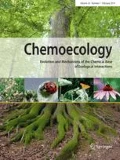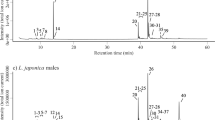Abstract
Tapinoma species, and more general dolichoderine ants, are able to produce a variety of volatile compounds they use as chemical defense, alarm, and communication pheromones. Among these, iridoids and volatile ketones are the predominant molecule classes produced by the anal glands of these ants. A recent taxonomic revision of the genus Tapinoma in Europe revealed that the supercolonial species Tapinoma nigerrimum consists of a complex of four cryptic species. Two of them, Tapinoma magnum and the newly described Tapinoma darioi, are closely related species that evolutionary diverged recently. In this work, we determine and characterize the chemical profile of pheromones and volatile compounds of two Tapinoma species. From a chemical point of view, T. darioi and T. magnum show both qualitative and quantitative differences in the pheromones produced, supporting the taxonomic revision of the T. nigerrimum complex. Our data confirm T. darioi and T. magnum as separate species also from a biochemical point of view demonstrating the value of chemotaxonomy as a suitable tool for integrative studies of species differentiation even for closely related taxa.







Similar content being viewed by others
References
Allan RA, Elgar MA, Capon RJ (1996) Exploitation of an ant chemical alarm signal by the zodariid spider Habronestes bradleyi Walckenaer. Proc R Soc B Biol Sci 263:69–73. https://doi.org/10.1098/rspb.1996.0012
Anderson MJ (2008) A new method for non-parametric multivariate analysis of variance. Aust Ecol 26:32–46. https://doi.org/10.1111/j.1442-9993.2001.01070.pp.x
Attygalle AB, Morgan ED (1984) Chemicals from the glands of ants. Chem Soc Rev 13:245–278. https://doi.org/10.1039/cs9841300245
Beckett JS, Beckett JD, Hofferberth JE (2010) A divergent approach to the diastereoselective synthesis of several ant-associated iridoids. Org Lett 12:1408–1411. https://doi.org/10.1021/ol100077z
Blum MS, Padovani F, Hermann HR, Kannowski PB (1968) Chemical releasers of social behavior. 11. Terpenes in mandibular glands of Lasius Umbratus. Ann Entomol Soc Am 61:1354–1354+. https://doi.org/10.1093/aesa/61.6.1354
Brown WV, Moore BP (1979) Volatile secretory products of an australian formicine ant of the genus Calomyrmex (Hymenoptera, Formicidae). Insect Biochem 9:451–460. https://doi.org/10.1016/0020-1790(79)90063-5
Bruckner A, Hoenle PO, von Beeren C (2018) Comparative chemical analysis of army ant mandibular gland volatiles (Formicidae: Dorylinae). PeerJ. https://doi.org/10.7717/peerj.5319
Cavill GWK, Clark DV (1967) Insect venoms attractants and repellents. 8. Isodihydronepetalactone. J Insect Physiol 13:131. https://doi.org/10.1016/0022-1910(67)90009-1
Cavill GWK, Ford DL (1953) The chemistry of ants. Chem Ind (London) 1953:351
Cavill GWK, Ford DL (1960) The chemistry of ants. 3. Structure and reactions of iridodial. Aust J Chem 13:296–310
Cavill GWK, Hinterberger H (1960) The chemistry of ants. 4. Terpenoid constituents of some Dolichoderus and Iridomyrmex Species. Aust J Chem 13:514–519. https://doi.org/10.1071/Ch9600514
Cavill GWK, Houghton E, Mcdonald FJ, Williams PJ (1976) Isolation and characterization of dolichodial and related compounds from argentine ant, Iridomyrmex humilis. Insect Biochem 6:483–490. https://doi.org/10.1016/0020-1790(76)90072-X
Cavill GWK, Davies NW, Mcdonald FJ (1980) Characterization of aggregation factors and associated compounds from the Argentine Ant, Iridomyrmex-Humilis. J Chem Ecol 6:371–384. https://doi.org/10.1007/Bf01402915
Cavill GWK, Robertson PL, Brophy JJ, Clark DV, Duke R, Orton CJ, Plant WD (1982) Defensive and other secretions of the Australian Cocktail Ant, Iridomyrmex nitidiceps. Tetrahedron 38:1931–1938. https://doi.org/10.1016/0040-4020(82)80042-2
Cavill GWK, Robertson PL, Brophy JJ, Duke RK, Mcdonald J, Plant WD (1984) Chemical ecology of the meat ant, Iridomyrmex purpureus sens strict. Insect Biochem 14:505–513. https://doi.org/10.1016/0020-1790(84)90004-0
Chauhan KR, Zhang QH, Aldrich JR (2004) Iridodials: enantiospecific synthesis and stereochemical assignment of the pheromone for the golden-eyed lacewing, Chrysopa oculata. Tetrahedron Lett 45:3339–3340. https://doi.org/10.1016/j.tetlet.2004.03.034
Crewe RM, Blum MS (1971) 6-Methyl-5-hepten-2-one—chemotaxonomic significance in an Iridomyrex Sp (Hymenoptera: Formicidae). Ann Entomol Soc Am 64:1007. https://doi.org/10.1093/aesa/64.5.1007
Davidson DW, Clark DA, Jones TH (2005) Gastral exocrine products of a myrmicine ant strongly overlap pygidial gland products of Dolichoderinae. Insect Soc 52:305–308. https://doi.org/10.1007/s00040-005-0810-4
Dawson GW, Pickett JA, Smiley DWM (1996) The aphid sex pheromone cyclopentanoids: synthesis in the elucidation of structure and biosynthetic pathways. Bioorg Med Chem 4:351–361. https://doi.org/10.1016/0968-0896(96)00012-0
Dietz A, Hermann HR, Blum MS (1979) Role of exogenous Jh-I, Jh-Iii and Anti-Jh (Precocene-Ii) on queen induction of 4.5-day-old worker honey bee larvae. J Insect Physiol 25:503–512. https://doi.org/10.1016/S0022-1910(79)80009-8
Do Nascimento RR, Billen J, Sant’ana AEG, Morgan ED, Harada AY (1998) Pygidial gland of Azteca nr. bicolor and Azteca chartifex: morphology and chemical identification of volatile components. J Chem Ecol 24:1629–1637. https://doi.org/10.1023/A:1020864427854
Duffield RM, Brand JM, Blum MS (1977) 6-Methyl-5-hepten-2-one in Formica species—identification and function as an alarm pheromone (Hymenoptera: Formicidae). Ann Entomol Soc Am 70:309–310. https://doi.org/10.1093/aesa/70.3.309
Feld BK, Pasteels JM, Boland W (2001) Phaedon cochleariae and Gastrophysa viridula (Coleoptera: Chrysomelidae) produce defensive iridoid monoterpenes de novo and are able to sequester glycosidically bound terpenoid precursors. Chemoecology 11:191–198. https://doi.org/10.1007/Pl00001851
Hamilton N, Jones TH, Shik JZ, Wall B, Schultz TR, Blair HA, Adams RMM (2018) Context is everything: mapping Cyphomyrmex-derived compounds to the fungus-growing ant phylogeny. Chemoecology 28:137–144. https://doi.org/10.1007/s00049-018-0265-5
Heethoff M, Laumann M, Weigmann G, Raspotnig G (2011) Integrative taxonomy: Combining morphological, molecular and chemical data for species delineation in the parthenogenetic Trhypochthonius tectorum complex (Acari, Oribatida, Trhypochthoniidae). Front Zool. https://doi.org/10.1186/1742-9994-8-2
Hefetz A, Lloyd HA (1983) Identification of New components from anal glands of Tapinoma simrothi Pheonicium. J Chem Ecol 9:607–613. https://doi.org/10.1007/Bf00990412
Hermann HR, Blum MS (1966) Morphology and histology of hymenopterous poison apparatus. I. Paraponera Clavata (Formicidae). Ann Entomol Soc Am 59:397. https://doi.org/10.1093/aesa/59.2.397
Hermann HR, Blum MS (1967a) Morphology and histology of hymenopterous poison apparatus. 2. Pogonomyrmex Badius (Formicidae). Ann Entomol Soc Am 60:661. https://doi.org/10.1093/aesa/60.3.661
Hermann HR, Blum MS (1967b) Morphology and histology of hymenopterous poison apparatus. 3. Eciton Hamatum (Formicidae). Ann Entomol Soc Am 60:1282. https://doi.org/10.1093/aesa/60.6.1282
Hermann HR, Blum MS, Wheeler JW, Overal WL, Schmidt JO, Chao JT (1984) Comparative anatomy and chemistry of the venom apparatus and mandibular glands in Dinoponera grandis (Guerin) and Paraponera clavata (F) (Hymenoptera-Formicidae-Ponerinae). Ann Entomol Soc Am 77:272–279. https://doi.org/10.1093/aesa/77.3.272
Kries H, Kellner F, Kamileen MO, O’Connor SE (2017) Inverted stereocontrol of iridoid synthase in snapdragon. J Biol Chem 292:14659–14667. https://doi.org/10.1074/jbc.M117.800979
Mcgurk DJ, Frost J, Waller GR, Eisenbraun EJ, Vick K, Drew WA, Young J (1968) Iridodial isomer variation in dolichoderine ants. J Insect Physiol 14:841. https://doi.org/10.1016/0022-1910(68)90194-7
Morgan ED (2009) Trail pheromones of ants. Physiol Entomol 34:1–17. https://doi.org/10.1111/j.1365-3032.2008.00658.x
Ohmura W, Hishiyama S, Nakashima T, Kato A, Makihara H, Ohira T, Irei H (2009) Chemical composition of the defensive secretion of the Longhorned Beetle, Chloridolum loochooanum. J Chem Ecol 35:250–255. https://doi.org/10.1007/s10886-009-9591-y
Oksanen J, Blanchet FG, Kindt R, Legendre P, Minchin PR, O’hara RB, Simpson GL, Solymos P, Stevens MHH, Wagner H (2013) Package ‘vegan’: community ecology package, version 2 (9)
Oldham NJ, Veith M, Boland W, Dettner K (1996) Iridoid monoterpene biosynthesis in insects: evidence for a de novo pathway occurring in the defensive glands of Phaedon armoraciae (Chrysomelidae) leaf beetle larvae. Naturwissenschaften 83:470–473
Pasteels JM, Braekman JC, Daloze D, Ottinger R (1982) Chemical defense in chrysomelid larvae and adults. Tetrahedron 38:1891–1897. https://doi.org/10.1016/0040-4020(82)80038-0
Pavan M (1975) Gli iridoidi negli insetti. Pubblicazioni Istituto di Entomologia Agraria Universita´ di Pavia 2:1–49
Scaffidi A, Algar D, Bohman B, Ghisalberti EL, Flematti G (2016) Identification of the Cat Attractants Isodihydronepetalactone and Isoiridomyrmecin from Acalypha indica. Aust J Chem 69:169–173. https://doi.org/10.1071/Ch15476
Scheffrahn RH, Gaston LK, Sims JJ, Rust MK (1984a) Defensive ecology of Forelius foetidus and its chemosystematic relationship to F (= Iridomyrmex) Pruinosus (Hymenoptera-Formicidae-Dolichoderinae). Environ Entomol 13:1502–1506. https://doi.org/10.1093/ee/13.6.1502
Scheffrahn RH, Sims JJ, Gaston LK, Rust MK (1984b) 4,11-Epoxy-cis-eudesmane, soldier cephalic secretion of the Nearctic Desert Termite, Amitermes minimus light (Termitidae, Termitinae). Experientia 40:1136–1137. https://doi.org/10.1007/Bf01971462
Schlick-Steiner BC, Steiner FM, Seifert B, Stauffer C, Christian E, Crozier RH (2010) Integrative taxonomy: a multisource approach to exploring biodiversity. Annu Rev Entomol 55:421–438. https://doi.org/10.1146/annurev-ento-112408-085432
Seifert B (2009) Cryptic species in ants (Hymenoptera: Formicidae) revisited: we need a change in the alpha-taxonomic approach. Myrmecol News 12:149–166
Seifert B, D’Eustacchio D, Kaufmann B, Centorame M, Lorite P, Modica MV (2017) Four species within the supercolonial ants of the Tapinoma nigerrimum complex revealed by integrative taxonomy (Hymenoptera: Fointicidae). Myrmecol News 24:123–144
Sherden NH, Lichman B, Caputi L, Zhao DY, Kamileen MO, Buell CR, O’Connor SE (2018) Identification of iridoid synthases from Nepeta species: Iridoid cyclization does not determine nepetalactone stereochemistry. Phytochemistry 145:48–56. https://doi.org/10.1016/j.phytochem.2017.10.004
Shi QX, Lu LH, Lei YY, He YR, Chen J (2017) Gland origin and electroantennogram activity of volatile compounds in ghost ants, Tapinoma melanocephalum (Hymenoptera: Formicidae) and behavioral response to (Z)-9-Nonadecene. Environ Entomol 46:1374–1380. https://doi.org/10.1093/ee/nvx164
Simon T, Hefetz A (1991) Trail-following responses of Tapinoma simrothi (Formicidae, Dolichoderinae) to pygidial gland extracts. Insect Soc 38:17–25. https://doi.org/10.1007/Bf01242709
Smith RM, Brophy JJ, Cavill GWK, Davies NW (1979) Iridodials and nepetalactone in the defensive secretion of the coconut stick insects, Graeffea crouani. J Chem Ecol 5:727–735. https://doi.org/10.1007/Bf00986557
Stokl J, Hofferberth J, Pritschet M, Brummer M, Ruther J (2012) Stereoselective chemical defense in the drosophila parasitoid Leptopilina heterotoma is Mediated by (−)-Iridomyrmecin and (+)-Isoiridomyrmecin. J Chem Ecol 38:331–339. https://doi.org/10.1007/s10886-012-0103-0
Tomalski MD, Blum MS, Jones TH, Fales HM, Howard DF, Passera L (1987) Chemistry and functions of exocrine secretions of the ants Tapinoma melanocephalum and Tapinoma erraticum. J Chem Ecol 13:253–263. https://doi.org/10.1007/Bf01025886
Trave R, Pavan M (1956) Veleni degli insetti: Principi estratti dalla formica Tapinoma nigerrimum Nyl. Chim Ind Milan 38:1015–1019
Trave R, Garanti L, Marchesi A, Pavan M (1966) Studies on chemical nature of components of odorous secrete of Lepidopterus cossus Cossus L. Chim Ind Milan 48:1167
van Oudenhove L, Boulay R, Lenoir A, Bernstein C, Cerda X (2012) Substrate temperature constrains recruitment and trail following behavior in ants. J Chem Ecol 38:802–809. https://doi.org/10.1007/s10886-012-0130-x
Weiss I, Rossler T, Hofferberth J, Brummer M, Ruther J, Stokl J (2013) A nonspecific defensive compound evolves into a competition avoidance cue and a female sex pheromone. Nat Commun. https://doi.org/10.1038/ncomms3767
Wheeler JW, Evans SL, Blum MS, Torgerson RL (1975) Cyclopentyl ketones—identification and function in Azteca Ants. Science 187:254–255. https://doi.org/10.1126/science.1111099
Wheeler JW, Olagbemiro T, Nash A, Blum MS (1977) Actinidine from defensive secretions of Dolichoderine ants. J Chem Ecol 3:241–244. https://doi.org/10.1007/Bf00988439
Wood WF, Hoang TT, McGlynn TP (2011) Volatile components from the mandibular glands of the turtle ants, Cephalotes alfaroi and Cephalotes cristatus. Biochem Syst Ecol 39:135–138. https://doi.org/10.1016/j.bse.2011.01.013
Acknowledgements
We want to thank Prof. Wilhelm Boland and Nanxia Fu (Max Planck institute for Chemical Ecology, Jena, Germany) for the technical support and for kindly providing Phaedon cochlearia extract. A.F. and L.W. acknowledge partial support by the Leibniz association through a Leibniz-DAAD postdoctoral fellowship to A. F. With this work, we continued an investigation started a few years ago with our colleague and brother Dario D’Eustacchio. His research led to the identification of a new Tapinoma ant species that later was named Tapinoma darioi in his honor, after he tragically passed away on the 14th of October of 2014 at the age of 35. This investigation has been carried out with no specific dedicated funding or grants (other than the travel grant to Germany) and was exclusively driven by the pure scientific passion, curiosity, and love for nature and for discovery, unique features of our dear friend Dario. This paper is dedicated to him and to his memory, still alive in our hearts.
Author information
Authors and Affiliations
Corresponding author
Additional information
Communicated by Günther Raspotnig.
Rights and permissions
About this article
Cite this article
D’Eustacchio, D., Centorame, M., Fanfani, A. et al. Iridoids and volatile pheromones of Tapinoma darioi ants: chemical differences to the closely related species Tapinoma magnum. Chemoecology 29, 51–60 (2019). https://doi.org/10.1007/s00049-018-00275-9
Received:
Accepted:
Published:
Issue Date:
DOI: https://doi.org/10.1007/s00049-018-00275-9




